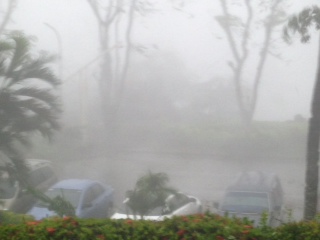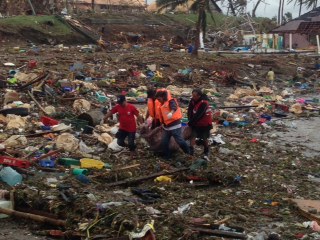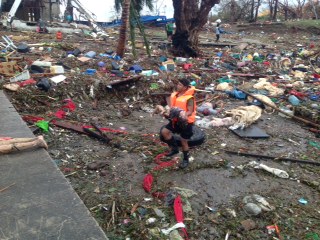Filtered by: Topstories
News
On assignment in the path of a super typhoon
By JIGGY MANICAD, GMA News
Days before landfall of super typhoon Yolanda, GMA News teams were deployed to Eastern Visayas to witness the strongest storm in human memory.
Despite our preparations, the experience was much more than we expected.
Despite our preparations, the experience was much more than we expected.
The idea was to just drive to the nearest town at risk of a landslide as the Leyte-Samar area is landslide-prone, according to the government's geo-hazard maps.
Although we expected typical typhoon coverage, that did not mean we wouldn't take extra precautions.
As a “ritual” when in the field, I bought our usual supplies of biscuits and water in case we get stranded along the way. These supplies would turn out to be life savers for my team, and a pantawid-gutom for other people as well.
As a “ritual” when in the field, I bought our usual supplies of biscuits and water in case we get stranded along the way. These supplies would turn out to be life savers for my team, and a pantawid-gutom for other people as well.
We managed to arrive at the Leyte Landing Memorial site in Palo just in time for my live newscast on “Quick Response Team” (QRT) that afternoon.
The following day, November 7, video journalists Ding Lagoyo, Winston Lucas and I visited the towns of Palo, Tanauan and Tolosa to get a feel of the preparations.
In Tanauan and Tolosa, people were already in evacuation centers. Around 393 families, mostly mothers and children, had already been evacuated to the Shrine of Nuestra Senora De Salvacion in Brgy. Bislig, Tanauan. Among them was Grade 6 pupil Ivan Dazo. He told me they have been praying that the storm will spare them.
The fathers had stayed behind to secure their homes along the coastal areas of Tanauan.
On the road to Tolosa, houses were being tied down and secured against the winds that the typhoon was expected to bring.
In Tolosa, we visited Brgy. Quilao, where around 35 families, again mostly mothers and children, had been evacuated. The men had stayed behind to secure their homes near the coastal area as well.
That night, we visited Palo and interviewed the town mayor. She said that they had prepared for the super typhoon and would be using with the municipal hall as their command post.
She said they had advised the people about a possible storm surge that could bring waves of up to 15 meters high. They also invited us for dinner as they had enough food, an invitation which we politely declined.
'Mukhang bakbakan 'to bukas'
Back in Tacloban, we made sure we had a full tank of diesel and instructed our driver to come early the next morning. I told him, “Jun, agahan mo, mukhang bakbakan 'to bukas.”
On November 8, Friday, at around 3 a.m., I was jolted awake by wild howling of the strong wind outside. The glass windows in my hotel room started to vibrate strongly and threatened to implode.
We started documenting everything, including the howling winds.
While sending videos over the internet, I was able to report to “Unang Hirit” and Super Radyo DZBB on the situation. The wall of the hotel room had developed cracks and the wind outside had pushed the airconditioning unit inward. We expected our roof to fly off as the wind slammed against steadily.
Outside was like being inside a giant washing machine. Steel waiting sheds crumpled and coconut trees snapped like matchsticks. That was around 6:30 a.m.


Yolanda's strong winds reduced visibility in Tacloban City to near zero. Jiggy Manicad, GMA News
At 7:30 a.m., all communications, including the internet, went dead.
I had covered disasters before, including the strongest storms that have hit the country—-Winnie, Reming, Ondoy, Pablo, the Habagats—-but the winds of Yolanda were so strong and low, I knew it would kill a lot, and destroy a lot.
While we were shooting, a piece of sheet metal started to slide towards the hallway where we were standing. I alerted my cameramen about that piece of yero he had about five seconds before it flew in like a bullet.
I managed to jump backwards behind the door jamb, and Ding and Winston managed to jump on a plant box on the hotel terrace.
While filming, I was praying. I knew that Yolanda was different. It was so different, we lost sight of the big ships anchored nearby. As the wind direction changed, they were swept sidewards, not along the coastline, but towards the communities.
At around 11:30 a.m., or after more than eight hours of strong rains and winds, the storm subsided.
Getting to Palo
We went out of the hotel to document what happened to the city. Communications were still down. The best way to send messages was through broadcast, using our satellite in Palo.
Without any means of transportation and with the road littered with fallen trees and lamp posts, Palo was five to six hours away by foot.
Just a few meters away, we counted 11 bodies on the coastline. Among the dead was a child. Red Cross volunteers had started to retrieve the bodies using whatever they could—refrigerator doors, blankets, mats.
Dead animals, mostly pigs and dogs, also littered the coastline.
Dead animals, mostly pigs and dogs, also littered the coastline.
What worried us more was the fact that Micaela Papa and her crew were billeted in Oriental Hotel, in Palo, fronting the sea. We needed to find them, I told my team.


Volunteers with the PHL Red Cross retrieve bodies within minutes of the storm subsiding. Jiggy Manicad, GMA News
We waded through flooded streets and climbed over fallen trees and posts.
In downtown Tacloban, everything was destroyed. Vehicles had been thrown on top of each other, others had been flipped over in front of buildings. Dead bodies, of people and of animals, lay on the sidewalks.
Here, we saw 10 people dead. Most of them were children in the nearby Panalaron Central School, which had been used as an evacuation center.
This is where I met Jaymar Caindoy, who was carrying his dead child, six-year-old Ellen Shane. She died inside the evacuation center.
Water rushed in, he said, and the victims drowned instantly.
This is where I met Jaymar Caindoy, who was carrying his dead child, six-year-old Ellen Shane. She died inside the evacuation center.
Water rushed in, he said, and the victims drowned instantly.
This early, people were already asking for help—for food, water and medicines for the wounded. But there was nobody there to answer the people’s pleas, to restore a sense of order, and to boost their spirits.


Volunteers with the PHL Red Cross retrieve the body of a child who died in the storm. Jiggy Manicad, GMA News
The biscuits and water I provided my team were steadily being depleted. People would approach us to ask for food and water, and we would share what we had, especially with the children.
By nightfall, we reached Palo, amidst strong rains. Our satellite team was huddled inside their truck, traumatized. They, together with the team of GMA News reporter Love Añover, had been caught in the middle of the typhoon's destruction as well.
They took cover inside the cathedral, only to witness its roof fall apart piece by piece.
I managed to convince the team to set the satellite up, so we could establish a line of communication. Ernie, our systems engineer, used a blow dryer on our equipment while the others repaired damaged audio and lighting systems.
Finally, I got on the air, on “24 Oras.”
Finally, I got on the air, on “24 Oras.”
By 9 p.m. , I was again back on air, this time on “State of the Nation with Jessica Soho” (SONA). After my 35-minute report, we decided to walk back to Tacloban to look for fuel and supplies for the entire satellite team, and for my team as well.
It was eerie along the way. Damaged roofs squeaked in the wind as if ready to fly at us and slice our heads off.
After six hours of walking , at around 4 a.m., my crew and team finally arrived in Tacloban.
There was no electricity and water. In the hallway of our hotel, we found a few journalists sleeping on the floor, among them Micaela and her crew. She said she had been looking for us too.
Together with the team from Al Jazeera, and the GMA Kapuso Foundation, I invited them to our hotel room so they could sleep in a bed that night.
The Aftermath
The second day, November 9, was a lot different. The people were hungrier and thirstier. I was one of them. I felt I wasn’t a journalist anymore. Having been caught in the eye of Yolanda, I felt like I was a victim, too.
I was tired, hungry, and thirsty. But I couldn’t show my team that I was feeling weak, I had to keep our spirits up. I prayed along the way.
I was tired, hungry, and thirsty. But I couldn’t show my team that I was feeling weak, I had to keep our spirits up. I prayed along the way.
We were again en route to Palo on foot. People would approach me to share the water I had in my bottle, and to ask for help, hundreds of them. Looting became rampant. Grocery carts filled with canned goods and other items were everywhere. Crates filled with food were being pulled away.
Rich and poor had nothing to eat and a nearby Gaisano Mall was ransacked for canned goods. Fastfood outlets were not spared either, and neither was a shop that was looted for shoes and computer chairs.
A group of men even told me that they would loot a grocery store in front of us named Godsend Grocery. I told them not to do it, but they did it just the same. The guard fired at them, but his bullet was no match for their thirst and hunger.
One of the men stole the store's cash register. Unable to take it any more, I shouted, “Hoy, makakain mo ba yan? Ibalik mo yan! Kapal naman ng mukha mo.” A lot of grandmothers and mothers echoed what I shouted.
The man put the register on the road for a few seconds, but picked it up again and fled anyway.
In the meantime, Palo's 16th century cathedral had become a makeshift morgue for around 30 bodies.
We arrived in Palo in time for “24 Oras Weekend.” People started to swarm around me, carrying with them pieces of paper, proofs of life, for me to bring the message to their relatives as there was no other means of communication.
I asked the people to line up behind me. At the very least, I thought, I could show their faces on camera to let their relatives know they were still alive.
Here, we met Mayor Sandy Javier of Javier town. He had arrived in Palo after clearing the roads during the last 36 hours.
He took it upon himself, using his personal resources, to do this. He said he could not wait for the provincial or national government to act. He wanted relief operations to get there fast. His people were going hungry too.

He took it upon himself, using his personal resources, to do this. He said he could not wait for the provincial or national government to act. He wanted relief operations to get there fast. His people were going hungry too.

More than 4 million children in areas struck by Yolanda face malnutrition. Claire Delfin, GMA News
Practically all the stores and malls were looted that day. After doing my live report for “24 Oras Weekend”, we went back to Tacloban. Again, I found myself shouting at a man, this time for looting computer monitors from a mall. This man, too, ran away.
Along the way, we saw thousands of people carrying whatever they could. Clothes from a nearby mall were stacked on the backs of motorcycles and entire display racks were carted away.
Back at the hotel, the owners asked us if we could “evacuate” their kids to safety in Cebu or Manila. They said that there had been reports that looters would hit their hotel next. To add to their fear, prisoners had managed to escape from the Tacloban jail as well.
We had a C-130 flight to Cebu the following morning, and while my team was on the manifest, I told the owners there was no guarantee that there would be space for more passengers. I said I would try to ask the pilots to accommodate the kids and their mom.
We were at the Tacloban airport by 2:00 a.m. to wait for a C-130 that arrived at 7:30 a.m.
There were about 50 of us on the plane, including journalists from Associated Press and other agencies. A few minutes later, we were in Cebu for our flight back to Manila.
There were about 50 of us on the plane, including journalists from Associated Press and other agencies. A few minutes later, we were in Cebu for our flight back to Manila.
This was one of the most dangerous and difficult coverages I’ve ever done because I was not just a journalist but a victim as well—inside the eye of super typhoon Yolanda. — JDS, GMA News
Tags: supertyphoonyolanda, tacloban
Find out your candidates' profile
Find the latest news
Find out individual candidate platforms
Choose your candidates and print out your selection.
Voter Demographics
More Videos
Most Popular





